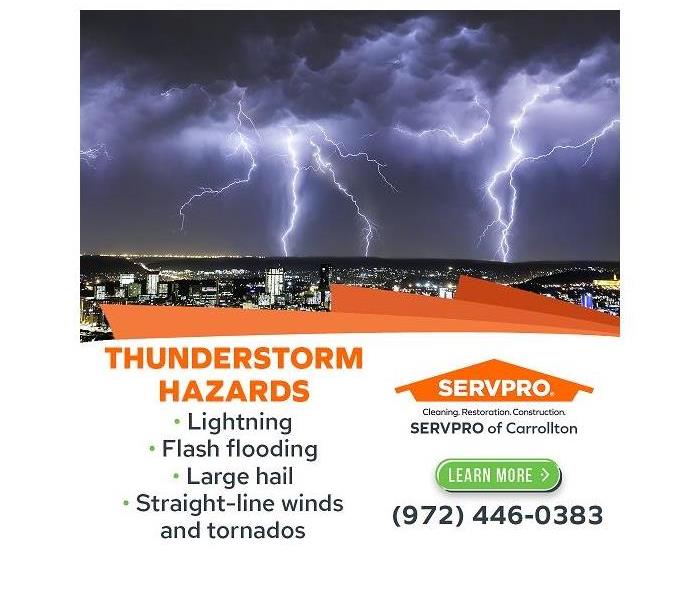Facts and Statistics about Thunderstorms and Storm Damage
10/11/2022 (Permalink)
Blog Summary: SERVPRO of Carrollton highlights storm damage statistics that help people understand the dangers that arise from thunderstorms.
The team of storm damage cleanup and restoration professionals at SERVPRO of Carrollton urges everyone to be aware of the hazards associated with a severe thunderstorm and the damage and personal injury it can inflict.
The power of knowledge to shape behavior
A thunderstorm is a microcell of dynamic weather energy that can leave a wake of devastation in its path. A stalled thunderstorm can flood a small area with many inches of rain. If the storm spawns tornadoes, the impact could be lethal. A realization of the threat posed by a thunderstorm can be a strong motivating factor to respect the storm and take the necessary precautions when turbulent weather approaches.
The knowledge of power: The threat hazard of a thunderstorm
Almost 1,800 thunderstorms are active at the same time in different places around the world, for an annual total of about 16 million storms. The US experiences 100,000 thunderstorms each year. Only about 10,000 of these storms are considered to be severe. To be rated as “severe,” a thunderstorm must have the following characteristics:
- generates winds of 58 mph or greater
- produces ¾-inch hail or larger
- may spin off tornadoes or tornadic activity
What it takes to make a thunderstorm
Three elements need to converge for a “thunder boomer” to form:
- moisture in the lower levels of the atmosphere
- unstable air caused by cold air circulating over warmer air
- a source of lift such as a colder air mass or an outflow of cold air from a nearby cluster of thunderstorms
Thunderstorm hazard: Lightning
Always keep in mind that every thunderstorm has the capacity to be dangerous because of the presence of lightning. The majority of lightning events travel from cloud to cloud. Cloud-to-ground strikes are the ones that kill over 90 people a year in the US.
The meteorologists at Weather.gov explain the formation of lightning: “Lightning is caused by the action of rising and descending air within a thunderstorm that separates positive and negative charges. Water and ice particles in the thunderstorm also affect the distribution of electrical charge. Lightning results from the buildup and discharge of electrical energy between positively and negatively charged areas. The average lightning strike has enough energy to light a 100-watt bulb for 3 months. The air near a lightning strike is heated to near 50,000 F, hotter than the surface of the sun. The rapid heating and cooling of the air near the lightning channel causes a shock/sound wave that results in thunder. Most lightning deaths and injuries occur when people are caught outdoors.”
Thunderstorm hazard: Flash flooding
The top danger hazard from a thunderstorm is not lighting but flash flooding. About 140 victims perish in flash flooding events from thunderstorms yearly in the United States. A band of severe thunderstorms or a stalled thunderstorm can dump enough rain to flood streets, yards, and homes in minutes. Roads are blocked by water and debris. Bridges and roads can be washed out, creating hazardous traveling conditions for motorists fleeing flooded areas. Never drive across an area of the road that has been flooded. Avoid bridges over streams and rivers swollen with flood waters.
Thunderstorm hazard: Large hail
Hail that is one or more inches in diameter is designated as “large.” Hail this size can cause serious property damage, about $1 billion annually. A severe hailstorm can damage shingles, dent shutters and roof vents, crack siding, shatter windows and windshields, ruin the exterior of a vehicle, damage landscape plants, and exfoliate trees. Lawn furniture, sheds, and power equipment can take a beating. The impact from a large hailstone traveling in excess of 100 mph can inflict personal injury.
Thunderstorm hazard: Straight-line winds and tornadoes
Straight-line winds cause most of the wind damage associated with thunderstorms. Downbursts with winds in excess of 100mph cause damage patterns similar to a tornado.
Tornadoes, sometimes with windspeeds of 300mph, are the most hazardous aspect of severe thunderstorms. Annually, eighty deaths and 1,500 injuries result from tornadoes.
Thunderstorm hazards present a real danger. The key to weathering the storm is to plan and prepare. An Emergency Ready Plan with food, water, flashlights, many batteries, basic first aid supplies, and two NOAA weather radios provide a good foundation for the Emergency Ready Plan.
When severe weather causes devastating storm damage, the SERVPRO® team is available 24/7, 365 days a year, including holidays, to provide cleanup and restoration services. Do not wait until after a disaster; instead, prequalify SERVPRO of Carrollton before a storm strikes.
For more information about storm damage restoration in Farmers Branch, TX, and nearby areas, call SERVPRO of Carrollton at (972) 446-0383 or email office@SERVPRO10952.com.

 24/7 Emergency Service
24/7 Emergency Service
